NRAO eNews
Volume 5, Issue 8
July 20, 2012
NRAO eNews
Volume 5, Issue 8 • July 20, 2012
Upcoming Events
![]() NRAO Semester 2013A Proposal Deadline
NRAO Semester 2013A Proposal Deadline
Aug 1, 2012
![]() CASPER Workshop
CASPER Workshop
Aug 13-18, 2012 | Green Bank, WV
![]() The Interstellar Medium in High Redshift Galaxies Comes of Age
The Interstellar Medium in High Redshift Galaxies Comes of Age
Sep 13-15, 2012 | Charlottesville, VA
![]() Molecular Spectroscopy in the Era of Far-IR Astronomy
Molecular Spectroscopy in the Era of Far-IR Astronomy
Oct 28-31, 2012 | Atlanta, GA
![]() The First Year of ALMA Science
The First Year of ALMA Science
Dec 12-15, 2012 | Puerto Varas, Chile
![]() Transformational Science with ALMA: From Dust to Rocks to Planets
Transformational Science with ALMA: From Dust to Rocks to Planets
Apr 8-12, 2013 | Kona, Hawaii
![]() IAU Symposium 299: Exploring the Formation and Evolution of Planetary Systems
IAU Symposium 299: Exploring the Formation and Evolution of Planetary Systems
Jun 2-7, 2013 | Victoria, British Columbia, Canada
Proposal Planning Webinar Presentations and Video
NRAO scientific staff broadcast a webinar on 11 June 2012 titled "Planning a Proposal for NRAO Telescopes." This webinar provided an overview of the research capabilities available to the community at each NRAO telescope, and discussed the key decisions and steps needed to assemble a successful observing time proposal.
For those who could not participate in the webinar, PowerPoint (*.ppt) and Adobe Acrobat (*.pdf) format versions of each webinar presentation, and video of each webinar talk, are on-line at the NRAO science web site.
ALMA Call for Proposals
Al Wootten
The submission deadline for the ALMA Cycle 1 Call for Proposals has passed. A total of about 1,161 proposals were received from astronomers around the world. The Cycle 1 review panel meetings are scheduled for 1-5 October 2012. Principal Investigators can expect to hear results of the Cycle 1 reviews in November of this year. Cycle 1 science observing is scheduled to begin on 1 January 2013 and will span 10 months.
ALMA Construction & Cycle 0 Early Science Operations
Al Wootten
At the end of June, there were 35 antennas at the ALMA Array Operations Site (AOS) in northern Chile. Sixty-two of the final sixty-six antennas are now in Chile; and 42 have been accepted. Fifty assembled Front Ends have been delivered to Chile.
During June, two of the biweekly Cycle 0 Early Science observing sessions were completed. The Cycle 0 observations and data processing are proceeding well. About half of the planned observing time is completed, and nearly half the total number of executions has been completed. One hundred thirteen datasets belonging to 38 projects have been or are in the process of being delivered. Several new papers based upon ALMA data appeared during June.
This Month @ the NAASC

Mark Rawlings and Alison Peck
 Zoom
Zoom
Meet the NAASC: Alison Peck
Alison Peck joined the North American ALMA Science Center (NAASC) as a member of the User Support Group on 4 June 2012. Alison has an extensive background in interferometry. She earned her MS at New Mexico Tech and NRAO working with Miller Goss on Australia Telescope Compact Array data, and then spent 2 years as a predoctoral fellow at the NRAO in Socorro studying red-shifted HI in absorption using global VLBI with her advisors Greg Taylor and Dave Westpfahl. Following the completion of her thesis, she moved to Bonn to continue working on VLBI projects with Karl Menten, as well as undertaking some new adventures in millimeter wave interferometry and single-dish observing using Institut de Radioastronomie Millimétrique (IRAM) telescopes. In 2001, she moved to the Harvard-Smithsonian Center for Astrophysics to join the Submillimeter Array (SMA) as a postdoctoral fellow in Hilo, HI, where she found that commissioning new instruments and optimizing observing strategies provides at least as much excitement as pure research. After a few years of integrating new antennas, software and capabilities, Alison took a staff scientist position as the Scheduling Officer at the SMA, interacting with PIs to help prepare observing scripts, as well as with engineers and operators to ensure that the array was performing as expected.
For the last 5 years, Alison has been stationed at the Joint ALMA Observatory in Chile in the role of Deputy Project Scientist, working with Richard Hills on ALMA Commissioning and Science Verification (CSV). Her duties included hiring and managing a Science Team for CSV in Chile and developing a CSV implementation plan that would allow the team to go from phase closure with 3 antennas to Early Science with 16 antennas in 20 months, and overseeing the observations and analysis of results for early ALMA Scheduling Block tests and Science Verification projects which would be suitable for public release. In addition, Alison maintained an active science curriculum, focusing primarily on nearby starburst galaxies and ULIRGs, as well as more distant submillimeter galaxies.
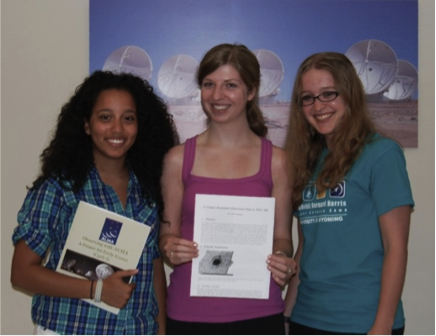
[left to right]: NRAO 2012 REU program participants Sinclaire Manning (Howard Univ.), Molly Gallagher (Grinnell College), and Rachel Smullen (Univ. Wyoming). Molly is holding the team's ALMA Cycle 1 proposal.
 Zoom
Zoom
NRAO REU Students Lead an ALMA Proposal
Kartik Sheth
Three undergraduates participating in this summer's NRAO Research Experiences for Undergraduates (REU) program have written and submitted an ALMA Cycle 1 observing proposal: Molly Gallagher (Grinnell College), Sinclaire Manning (Howard Univ.), and Rachel Smullen (Univ. Wyoming).
Challenged with the idea of writing an ALMA proposal (and a promised reward of a free dinner), these enterprising students took the initiative to learn about ALMA, download and use the ALMA Observing Tool, and write and submit an observing proposal! All the co-Investigators agreed that although the experience was challenging, it was extremely rewarding. "The hardest part was learning the technical jargon and devising the observing strategy," said Molly Gallagher, who was the proposal PI. The team requested ALMA observing time to map the molecular gas via the CO(2-1) emission line in a spectacular XUV disk in the galaxy NGC 289, chosen initially from the Spitzer Survey of Stellar Structures in Galaxies (S4G). In a week, these REU students will travel to the Jansky Very Large Array near Socorro, New Mexico to get a first hand look at a working radio interferometer like ALMA.
ALMA on NBC
A 10-minute network TV story about ALMA was broadcast in the US on Thursday evening, 5 July on the NBC News program Rock Center with Brian Williams. The program featured NBC correspondent Harry Smith and NRAO scientist Scott Ransom visiting the ALMA site together. The program is available on the show's website.
Transformational Science with ALMA: From Dust to Rocks to Planets
Kona, Hawaii, 8-12 April 2013

The North American ALMA Science Center (NAASC), in cooperation with the Academia Sinica Institute of Astronomy and Astrophysics (ASIAA) in Taiwan, is pleased to announce the 7th NAASC workshop entitled: “Transformational Science with ALMA: From Dust to Rocks to Planets – the Formation and Evolution of Planetary Systems." This NAASC-ASIAA "2013 Rocks!" workshop will be held 8-12 April 2013 on the Big Island of Hawaii.
In this workshop, investigators from around the world will explore the evolution of protostellar disks from formation to dissipation, particularly at radio to submillimeter wavelengths. A focus of the workshop will be the processing of the gas and dust components, and the growth of planetesimals. We will also explore chemical changes, and radiative signatures from millimeter to submillimeter wavelengths. We will showcase results from ALMA early science projects and feature synergies with other telescopes, including the Karl G. Jansky Very Large Array and telescopes located on Hawaii.
Ewine van Dishoeck will be the Keynote Speaker at the Workshop. Dr. van Dishoeck holds the title of Professor of Molecular Astrophysics at the Leiden Observatory in the Netherlands and is an expert on observational, laboratory, and theoretical astrochemistry.
Don’t miss this opportunity to explore great science. The workshop will be held at the Hilton Waikoloa Village located on the Kohala Coast of the Big Island of Hawaii. Snorkeling, a tour of the telescopes on Mauna Kea, gorgeous sunsets, and an authentic Hawaiian luau are just some of the local attractions. Daily direct flights are available from the US, Canada, and Asia.
Please visit the workshop web site at http://www.cv.nrao.edu/rocks/ for additional information. Be sure to ‘like’ us on Facebook https://www.facebook.com/2013Rocks.
2013 Rocks! is committed to broadening participation by women and under-represented minorities.

IAU Symposium 299: Exploring the Formation and Evolution of Planetary Systems
Victoria, British Columbia, Canada, 2-7 June 2013
This is the first announcement for the 299th Symposium of the International Astronomical Union (IAU), "Exploring the Formation and Evolution of Planetary Systems", co-organized by the Dunlap Institute for Astronomy & Astrophysics and the National Research Council of Canada. The goal of this meeting is to bring together the communities studying the formation of planets in protoplanetary discs and those who study evolved exoplanet systems. The timing is chosen to highlight the first results from a number of new facilities and instruments which will impact these fields.
Topics will include:
- Observations of protoplanetary discs, debris discs and exoplanets
- Planetesimal and planet formation
- Exoplanet atmospheres and interior structure
- Dynamics in planetary systems: migration, multiplicity and planet-disc interactions
The meeting will be held at the Victoria Conference Centre in the heart of picturesque Victoria, British Columbia, on Canada's Pacific coast. Local attractions include whale watching, wine tours, the world-famous Butchart Gardens, and the Dominion Astrophysical Observatory. Excellent beaches, diving, camping and hiking are all within a day's drive from Victoria.
Registration will open on 1 September 2012, but those interested in attending the meeting are welcome to submit their names to our pre-registration list. Pre-registrants will be sent the invitation to register for the meeting directly, but places are not reserved once registration is officially opened. There will be a hard limit of 200 attendees for the symposium. To pre-register and be placed on the mailing list, just send an email indicating your interest to the conference email: iaus-299@di.utoronto.ca.
CASA Release 3.4.0
The CASA Team
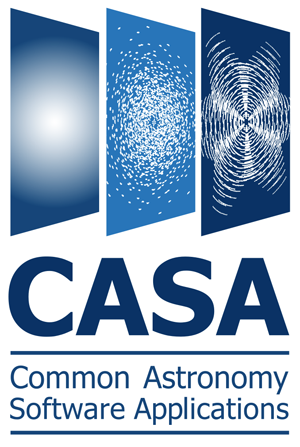
We are pleased to announce a new release of CASA (3.4.0).
CASA, the Common Astronomy Software Applications (CASA) package is being developed by NRAO, ESO, and NAOJ and is used for the offline reduction and analysis of both ALMA and EVLA data. CASA is fully scriptable. Full support is provided for ALMA, VLA, and Jansky VLA formats, but almost any data that can be written in uvfits format can be imported and reduced in CASA (for example, CARMA, SMA, ATCA).
Linux and MacOS distributions of CASA 3.4.0 are now available from the CASA webpage: http://casa.nrao.edu
Please follow the links to "Obtaining CASA".
We changed the supported Operating Supports to include: Linux (64bit): RedHat 5.7, Fedora 16, Ubuntu 11 Mac OS: 10.6 (Snow Leopard), 10.7 (Lion)
We are currently working to resolve an issue with the 32-bit Linux distribution, and we will make this available as soon as possible.
A sample of the new features in CASA 3.4.0 include:
- New flagging infrastructure with substantially improved performance and extended capabilities
- New autoflagging algorithms (tfcrop, rflag)
- New calibration table format (not compatible with the old format)
- MODEL column is now optional
- Clean can calculate a spectral index error map
- Experimental parallelized clean task
- Automatic lookup of EVLA antenna position changes
- Improved feather task, including new parameters for weighting data, single dish amplitude scaling, and plotting
- New CASA region syntax is now partially supported in the viewer
- Gaussian and polynomial fitting of spectra in the viewer spectral profile tool
For a full list, see the release notes online. We encourage you to subscribe to either or both of the following subscription lists:
Subscribe for announcement of new releases, workshops, etc.
Subscribe for critical bugs and code updates
If you have any questions, please consult the NRAO helpdesk or the ALMA helpdesk.
The Interstellar Medium in High Redshift Galaxies Comes of Age
Charlottesville, Virginia, 13-15 September 2012
Workshop focus items will include all aspects of the study of molecular emission at high redshift. More information will be made available as the structure of this conference evolves.
Brown and vanden Bout published a detection of CO emission from a galaxy at z = 2.3 using the NRAO 12m telescope in 1991. In the 21 years since this CO detection, radio emission lines have become an indispensable tool for tracing molecular gas throughout the Universe. Today molecular and atomic lines at many wavelengths provide complementary insights into the structure of the ISM in galaxies early in the history of the Universe. New observing capabilities enrich our understanding of the evolution of galaxies, using modern instrumentation available at new and expanded facilities worldwide. The workshop will examine the current status and future directions of research using spectral lines to probe the high redshift Universe. The event will also focus on the contributions of recently retired, former NRAO Director Paul vanden Bout.
Registration is open at: https://science.nrao.edu/facilities/alma/naasc-workshops/HizISM/index
RadioAstron Operational
Ken Kellermann
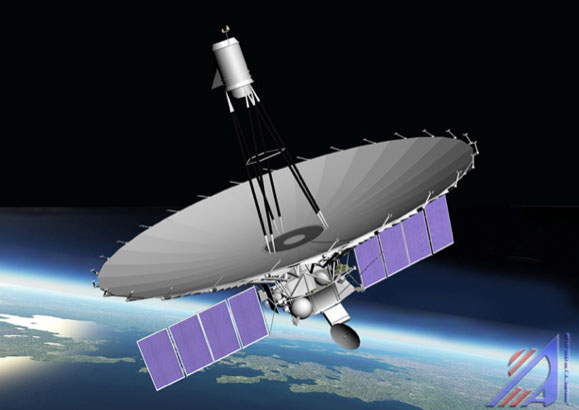
After more than three decades of planning and development, the RadioAstron space VLBI satellite was launched from the Baikonour Cosmodrome on 18 July 2011, and placed in a highly elliptical orbit extending some 350,000 km from the Earth. Starting in November 2011, following a period of in orbit check-out and calibration of the 10-m antenna and associated instrumentation, fringes have been detected in all four P, L, C, and K bands, including fringes between the space radio telescope and the Green Bank Telescope (GBT) at L and C bands. In response to proposals, an early science program covering AGN, masers, and pulsars that began in February 2012 has been awarded time on the GBT, Arecibo, the European VLBI Network, as well as a number of other antennas in Russia, Ukraine, Japan, and Australia. Correlation is being done primarily at the Astro Space Center in Moscow, but also at the Max Planck Institut für Radioastronomie in Bonn on a modified DiFX correlator. So far fringes have been detected on seven AGN. The longest projected baseline to show AGN fringes was about 90,000 km at 6 cm on OJ 287 suggesting an angular size not more than about 30 micro-arcseconds. An even longer baseline of 220,000 km showed fringes on the pulsar B0950+08 at 92 cm.
The 1.3 cm receiver on RadioAstron includes two low noise preamplifiers provided by the NRAO Coordinated Development Lab that were modeled after similar devices built for the Wilkinson Microwave Anisotropy Probe. Using NRAO amplifiers, fringes have been detected on the quasar 2013+370, as well as on a water maser source in W51 over a projected baseline just over one Earth diameter, making it the highest resolution spectral line observation ever made.
At its recent meeting in Moscow, the RadioAstron International Science Council (RISC) supported the plans to issue a call for proposals for an Open Skies phase of RadioAstron built around a limited number of key science programs including AGN, masers, pulsars, the ISM, gravity, and astrometry. Discussions are underway between NRAO and the RadioAstron mission to implement a tracking station in Green Bank using the 140-ft antenna to receive the RadioAstron downlink data stream. It is hoped that the Green Bank tracking station will be in operation by the beginning of 2013, as needed to support the Open Skies programs, and in particular will greatly improve the opportunity for co-observing with the GBT.
More information about the status of RadioAstron can be found on the mission web site.
The NRAO Summer Students Have Landed
Jeff Mangum
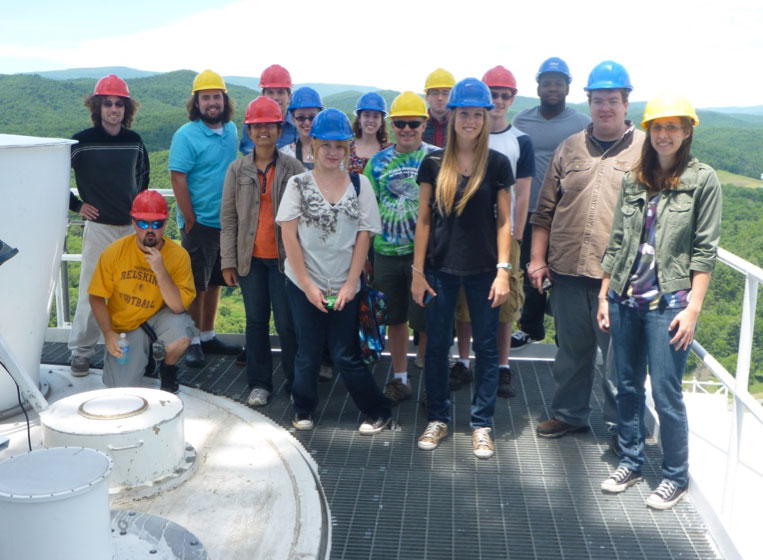
Figure 1. Several NRAO Green Bank and Charlottesville summer students – and one notable former summer student! – inspecting the focal plane of the Green Bank Telescope.
 Zoom
Zoom
Now in its 53rd year, the NRAO summer student program welcomed 28 undergraduate and graduate students as summer research interns in Green Bank, Socorro, and Charlottesville. Over the next 10 to 12 weeks these students will work on a research project with an NRAO scientist or engineer, participate in a lecture series designed to give them a broad exposure to a variety of astrophysical research topics, and design and execute their own science experiments with one of the NRAO telescopes. The primary goal of the NRAO summer student program is and has always been to introduce young scientists to scientific research. These students are also given the opportunity to present their research at the American Astronomical Society meeting held the following January, allowing them the opportunity to network with the broader astrophysical community.
Synthesis Imaging Workshop
Amy Mioduszewski
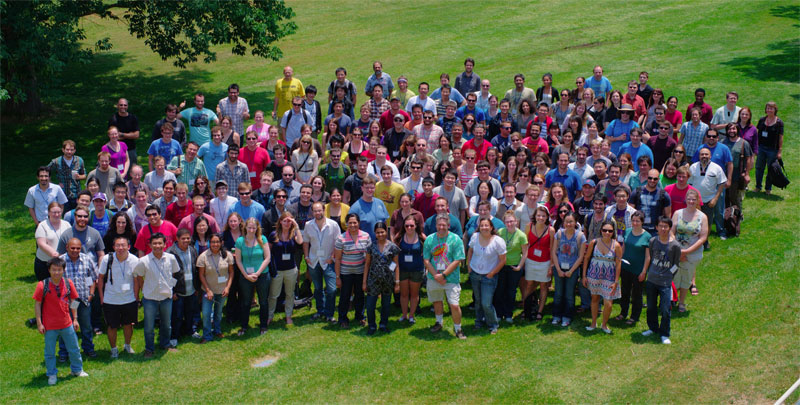
 Zoom
Zoom
The 13th Synthesis Imaging Workshop was held May 29-June 5, 2012 in Socorro, NM. Most of the workshop was held at Workman Center on the campus of the New Mexico Institute of Mining and Technology (NMT). The data reduction tutorials were partially held at NRAO's Domenici Science Operations Center in Socorro. There were four days of lectures, two days of data reduction tutorials, and two afternoons of observation preparation tutorials. Other events included a reception, workshop dinner, hikes of the Magdalena Mountains and the Bosque del Apache, and a very popular tour of the Jansky Very Large Array (VLA).
There were 156 registered participants from 20 countries. Over half (71%) the participants were graduate students; scientific and engineering staff (13%), postdocs (8%), undergraduates (6%) and faculty (2%) also attended.
New this year were the observation preparation tutorials. The students spend two afternoons learning the important considerations for observing and how to prepare for VLA and ALMA observations. There were also two full days of data reduction tutorials. Participants could choose tutorials using VLA, VLBA, LWA and/or ALMA data. The ALMA datasets were new: CO and HCO+ observations of the nearby T Tauri star TW Hydra; and a mosaic of the Antennae interacting galaxy pair. The datasets and a guide to reducing them in CASA can be found at http://casaguides.nrao.edu/.
Fourteen of the 24 lecturers were from NRAO. The other lecturers were from National Research Council Canada, the Netherlands's ASTRON, Harvard-Smithsonian CfA, New Mexico Tech, University of New Mexico, Purdue University, and Caltech. We thank all the lecturers for giving their time and talents to the workshop.
There was a special treat on the last day of the workshop: the transit of Venus was visible in the afternoon from Socorro. All the participants were provided solar glasses and telescopes were set up outside the Science Operations Center and the Etscorn Observatory on New Mexico Tech campus. All the students had a great view of this rare event.
We thank NRAO and AUI for providing logistical and financial support and a majority of the lecturers. We are grateful to New Mexico Tech (NMT) for providing the use of their facilities, and particularly support of the NMT Physics department. We also thank the University of New Mexico and the New Mexico Consortium at Los Alamos National Laboratory for financial support.
Recent Press Releases
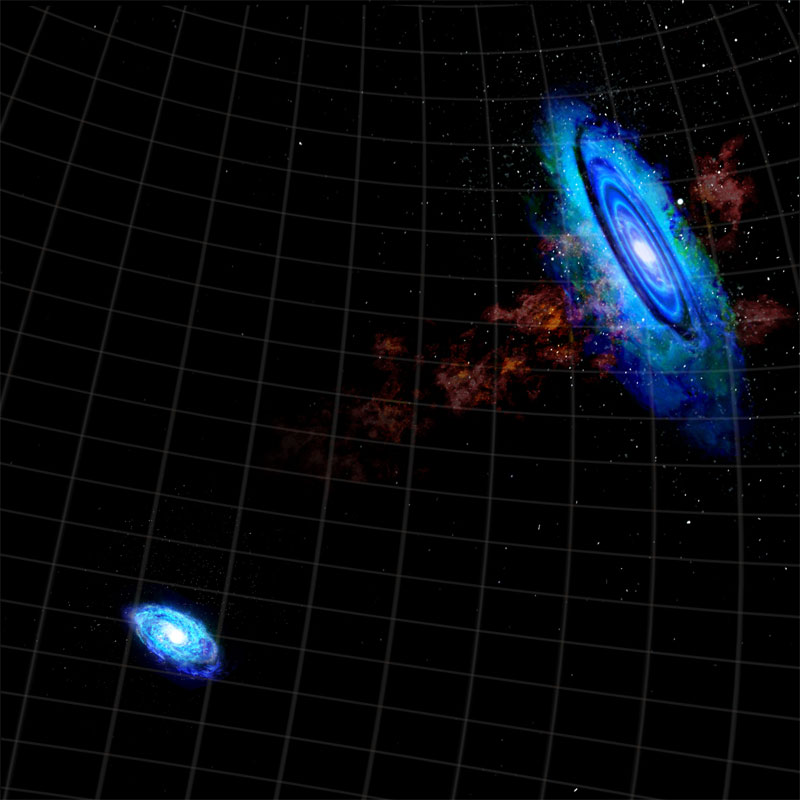 Neighbor Galaxies May Have Brushed Closely, Astronomers Find
Neighbor Galaxies May Have Brushed Closely, Astronomers Find
11 June 2012
Two of our Milky Way's neighbor galaxies may have had a close encounter billions of years ago, recent studies with the National Science Foundation's Green Bank Telescope (GBT) indicate. The new observations confirm a disputed 2004 discovery of hydrogen gas streaming between the giant Andromeda Galaxy, also known as M31, and the Triangulum Galaxy, or M33. Read More …
Career Opportunities
New Postings
ALMA Operations Astronomer: The Joint ALMA observatory (JAO) in Santiago, Chile is seeking an ALMA Operations Astronomer. The incumbent will work in the ALMA Program Management Group within the JAO Department of Science Operations. The JAO Department of Science Operations (DSO) is responsible for the ALMA observations. It consists of three groups: the Array Operations Group, the Program Management Group (PMG) and the Data Management Group (DMG). The PMG is responsible for scheduling and tracking of projects as well as data quality assurance during the observations.
ALMA Postdoctoral Fellow: The Joint ALMA observatory (JAO) in Santiago, Chile is accepting applications for ALMA Postdoctoral Fellows to support ALMA science operations. Successful candidates will work in the JAO Department of Science Operations (DSO), which is responsible for observations, data processing and the proposal review process. They will perform their duties as part of the large team of international scientists working at JAO and in the ARCs.
Controller-AUI: Associated Universities Inc., in Washington, DC is recruiting for a Controller-AUI. Reporting to the AUI Chief Financial Officer (CFO), the Controller will be responsible for oversight of all daily finance, accounting, and reporting activities of the AUI Corporate Office and managed facilities. As the primary support for the CFO, the Controller will be involved in supporting preparation of presentations to the AUI Board of Trustees and the AUI Audit Committee and will work closely with senior management.
Assistant Director, ALMA North American Operations: The NRAO in Charlottesville, Virginia is seeking an Assistant Director for ALMA North American Operations to ensure ALMA NA operations achieve maximum scientific and cost effectiveness of ALMA, and to work in close coordination with the NRAO Director.
Director – ALMA: The Joint ALMA observatory (JAO) in Santiago, Chile is seeking a Director to provide leadership and scientific abilities in the multinational environment of ALMA. The incumbent will have overall responsibility of leading the observatory and for reporting to the ALMA Board on all aspects of the facility. Specifically the Director is responsible for completing within budget the construction phase of ALMA, ensuring the successful transition to full operations, and subsequently operating the observatory to realize its full scientific potential.
Software Engineer II: The NRAO in Socorro, NM is recruiting for a Software Engineer II. Initially he/she will work with other Scientific Support System group members and Open Sky staff to re-insource the Proposal Submission Tool (PST), User Database (UDB), and portal development and maintenance to the NRAO. The Software Engineer will work with our database administrator (DBA) on database issues as well as with our web master on issues like hosting and deploying the PST and portal.
Web Developer: The NRAO in Charlottesville, Virginia is accepting applications for a Web Developer. The Web Developer will be responsible for developing, testing, implementing, and supporting the NRAO science and staff websites. Working as part of the NRAO web team: (1) develop web-based interactives, products, and mobile device applications; (2) administer content management system for the science and staff sites; (3) define and codify technical requirements for products; and (5) maintain a broad knowledge of browser capabilities and web development trends.
From the Archives
Ellen Bouton

About this month's photo: On 9 July 1965, Peter Mezger and Bertil Höglund detected radio recombination lines using the NRAO 140-foot telescope. This photo from Jaap Baars shows Peter Mezger in a red shirt, Bertil Höglund tying his shoes and Jaap Baars leaning against Peter's Chevy. Jaap says, "The picture was made in the summer of 1965 at the start of a hike from Durbin to the Cheat River Falls. I have always connected this picture with 'two tired scientists relaxing after their unambiguous detection of the hydrogen recombination line H109α with the new 140-ft telescope.' " Commenting on his own presence in the photo, Jaap added, "As to the third 'tired scientist,' I was not involved in the recombination line work at all. So I assume that I was not tired." Thanks to Jaap Baars for the photo and caption information. Mezger's description of the discovery (no mention of the hike) may be read on page 5 of The Observer, v.10 #3, May 1970.
From the Archives is an ongoing series illustrating NRAO and U.S. radio astronomy history via images selected from our collections of individuals' and institutional papers. If readers have images they believe would be of interest to the Archives, please contact Ellen Bouton, ebouton@nrao.edu.

